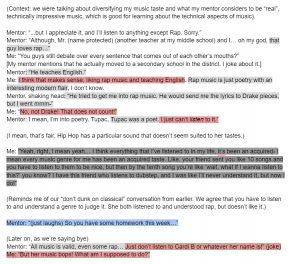Fifth In-Depth Blog Post
Good day!
Welcome to my fifth blog post for In-Depth, once again fashionably late! This time, we have a pretty interesting topic called the Six Hats. First up though is our regularly scheduled progress report.
Progress Report
Due to some more difficulties with the schedule, I wasn’t making a satisfying amount of progress in the beginning, but after this week’s meeting, I have much more to do and I’ve done quite a bit more. During the meeting, my mentor touched on consonants again, showing me a way to improve my voiced consonants that involved saying the “peter piper picked a peck of peppers” tongue twister with your hand in front of your face until you could feel the air from the letter P on the palm of your hand.
We’ve begun discussing my final project, mostly brainstorming ideas. My mentor and I discussed how I wanted to choose a song for each skill I’ve touched on, and she listed off all the skills she wanted to go over with me before the project wraps up. She recommended I choose an overall theme, in terms of genre or style, but we couldn’t really settle on one. She talked about breath control and phrasing today, saying that I should find some songs with long phrases to practice singing with an understanding of where and how to breathe. I also got a brief lesson on vowel sounds. I might go over that lesson in another blog post, talking about the ‘Ah’ sound and the way Italian is a good language to sing in to practice your vowels.
This lead to her recommending some cool Canadian musical artists to me, and we had a conversation about music history. She told me that I should diversify my music taste this week and practice “active listening”. Active listening is when you listen to a piece with the intent to gain something practical from it, like studying the structure as the song goes on to replicate it or studying a piece you’re going to play to better understand some musical aspects. She said this is why she recommends I listen to more “real” music, like classical music (which she claims is more active and engaging, requiring a musician’s ear, which is why it’s often misunderstood), jazz, classic rock (70s era) or opera. She imparted a lot of knowledge about how listening to music is extremely important in your journey to creating it. I can’t find the place in the meeting recording where she said this, but I remember her saying that music is not just enjoyment, it can also be learning and so much more than that. On top of the exercises she’s given me, I will be “expanding my horizons!” (direct quote) these next few weeks!
https://youtu.be/jOIAi2XwuWo Legendary opera singer Jessye Norman performing When I Am Laid In Earth (composed by Henry Purcell), probably one of the most moving and utterly beautiful things I have seen/heard on the internet, like ever, thank you to my mentor for recommending Jessye Norman. I have so much to say about her and how I actively listened through this piece but I have to be concise!
The Six Hats – Explanation and Conversation
The Six Hats is a method of discussion created by author and thinker Edward DeBono. The idea is that everyone is always on the same page at a given point in a conversation, or doing “parallel thinking”. Each hat colour represents a different perspective on a situation or method of thinking. The “white hat”, gathering information as a group, no matter what kind of information that is, and laying it out there to be examined, the “red hat”, feelings, emotions, and intuition, accepted in a matter that doesn’t require justification like in the standard arguing format we all know, the “black hat”, our standard critical-thinking, hole-poking, logic-based-judging hat, our rare but extremely valuable “yellow hat” that examines our values and the benefits for outcomes of the situation, the “green hat”, the creative hat that is all about looking for possibilities, alternatives and solutions, and the “blue hat” that organizes, controls and conducts, establishing the intent of a conversation at first and continuing to keep it on course by outlining which hat is being used when to maintain a good flow. For more info on these hats, including the questions that will better define the hats, see How To Have a Beautiful Mind by Edward DeBono.
Below, I have transcribed a debate between my mentor and I about music, highlighting situations where different hats could have applied or were used. This wasn’t exactly a Six Hats conversation, but I tried my best to use the hats when I could.
Thank you for reading! Unfortunately, I will be taking a break from adding a singing clip into my blog post today, but I hope the additional resources I share will make up for that. This stretch-of-time-between-blog-posts was mostly focused on re-focusing, and I learned a lot about active listening, singing exercises, diversifying my taste, and ways I can improve my songwriting. I really appreciate how my mentor understands the role of my songwriting in my singing journey and tries to accommodate for that in what she teaches me as much as possible. The Six Hats are a really interesting subject, and I’m curious enough to want to read more about them. I hope you enjoyed reading my blog post. Have an excellent day!
Google Drive link (past singing clips, this week’s meeting clips, etc): Here!

